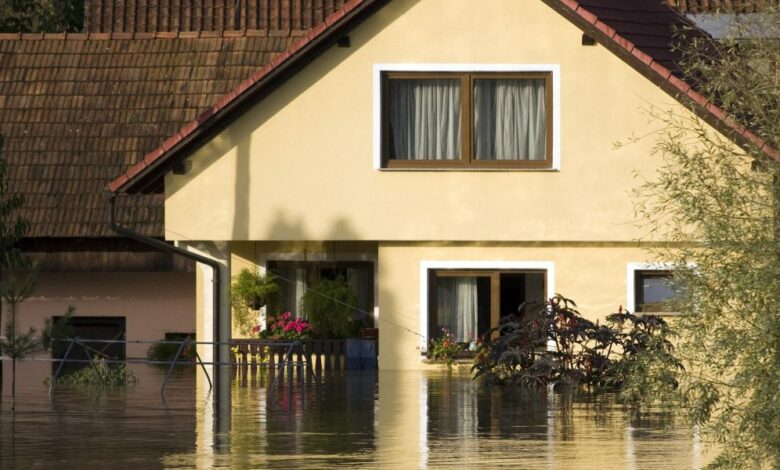Flood insurance: Why you might need a separate policy


Flooding can happen just about anywhere, and the resulting harm on one’s property can range from nuisance to catastrophic.
In fact, as little as one inch of floodwater can cause up to $25,000 in damage, according to the Federal Emergency Management Agency (FEMA). To add insult to injury, homeowners insurance almost never covers flood damage. This requires a separate policy in addition to your homeowners insurance policy.
So what is a renter, business, or homeowner to do? “The best way to mitigate the risk of flood is to avoid buying a home in a known flood zone at all costs,” says Mark Snyder, claims subject matter expert at Hi Marley, an insurance communications platform. “However, and speaking from painful personal experience, not all floods occur in flood zones.” Unfortunately, flooding has affected 99% of U.S. counties since 1996, according to FEMA.
What is flood insurance, and how does it work?
Flood insurance, like all insurance, is a contract between you and an insurer through which you pay the insurer to cover your losses. In this case, flood insurance would cover any losses owing to flooding or flood-related erosion caused by waves or currents accompanied by a severe storm, a flash flood, an abnormal tide surge, or something similar. Flood insurance rates rely on government-created flood zone maps designed to make insurance available to homeowners, renters, and businesses.
Flood zones fall into three categories: high-risk, moderate-to-low risk, and undetermined risk.
- High-risk flood zones present at least a one-in-four chance of flooding during a 30-year mortgage. All home and business owners in these areas, known as Special Flood Hazard Areas (SFHAs), with federally regulated or insured mortgages are required to buy flood insurance.
- Moderate-to-low risk zones have less risk but not none. These areas submit over 20% of National Flood Insurance Program (NFIP) claims and receive one-third of disaster assistance for flooding, according to FEMA. While flood insurance isn’t mandated in these areas, it is recommended for all property owners and renters.
- Undetermined flood zones, as you might expect, are areas where flood-hazard analysis has not been conducted. This does not mean a flood risk does not exist. As with moderate-to-low risk zones, insurance is not required in these areas.
A recent development at FEMA is a flood-zone mapping update called Risk Rating 2.0 that provides property-specific flood rating based on much more data than FEMA’s older flood-zone system. The purpose of this new system, according to FEMA, is to address rating disparities and ensure all property owners are paying their share of flood risk.
Flood insurance providers and options
Most flood insurance is administered by the federal government either directly through the NFIP or through a network of private insurers approved to issue a FEMA Standard Flood Insurance Policy (SFIP) under the FEMA Write Your Own (WYO) program. WYO essentially lets private insurers issue flood insurance policies in their own name but underwritten by FEMA (subject to NFIP rules and guidelines). NFIP and WYO coverage is available in more than 24,000 U.S. communities that fall into one of the three flood zone categories. As noted above, homes and businesses in SFHAs with mortgages from government-backed lenders are required to have flood insurance.
Private (non-government-connected) flood insurance is also available. Private insurers can be more selective about which properties they insure but can also offer coverage not available through either the NFIP or WYO.
“The biggest advantage to individuals is they have a choice when it comes to flood insurance,” says Craig Poulton, CEO of property and casualty insurance provider Poulton Associates, LLC. “They can choose better coverage and lower prices that would not be available in the absence of a private market.”
When shopping for a private carrier, Poulton cautions, “it’s important to understand that a great deal of private flood insurance is written on the same form as the NFIP, meaning that these insurers are offering similarly limited coverage.” In other words, don’t assume all private insurance is alike—read the policy’s fine print.
5 things to consider when signing up for flood insurance
1. If you’re buying a new home, ask the agent
When deciding about flood insurance as a homebuyer, ask your agent whether the property lies in a FEMA flood zone. “There is a federally prescribed disclosure that is given to borrowers who are going to close a mortgage on a home in a high-risk flood zone,” says Scott Giberson, principal of flood compliance at CoreLogic. “As of 2015, this disclosure includes a directive to the borrowers to compare the flood insurance coverage, deductible, exclusions, conditions, and premiums associated with both NFIP and private, and to discuss those differences with an insurance agent.”
2. Do your research
Consider steps you can take to both understand and reduce risk independent of buying flood insurance. Regardless of flood-zone status, Snyder advises potential homebuyers to avoid buying the lowest-elevation house in the neighborhood and to ask for at least 10 years of water intrusion history for the property.
3. Understand the limitations of the flood zone maps
Make sure you understand that despite the rollout of Risk Rating 2.0, flood zone maps are often out of date and incomplete. According to Poulton, many homeowners live in a flood plain, but in an area that has not been designated as such by the NFIP. Experts agree, he says, that roughly 50% of structures that should be included in flood plain maps are not included.
4. You probably need flood insurance, no matter what
You should still purchase flood insurance even if you don’t live in a high-risk flood zone. Attorney Evan Walker, who represents policyholders with flood damage claims, advises homeowners to purchase flood insurance whether it’s required or not, saying, “I’ve handled cases where clients’ homes have flooded because of government negligence, and because the textbook definition of floodwater is outside water coming in, the insurance company refused to cover the damage.”
5. Renters might also want to get flood insurance
Even if you don’t own property and just rent, flood insurance might still be valuable to have. As with homeowners insurance, renters insurance does not cover flood damage. Even if your landlord has flood insurance, it won’t pay for damage to your personal belongings. Flood insurance for renters is available for as little as $100 a year.
What does flood insurance cover?
If you’re a renter, flood insurance covers your belongings only.
For homeowners, there are two main types of coverage: dwellings and contents. FEMA dwelling coverage is capped at $250,000. Contents coverage only goes up to $100,000, and there is a 30-day waiting period before coverage begins.
Dwelling ($250,000 FEMA)
What’s covered:
- Main building
- Electrical and plumbing systems
- Furnaces and water heaters
- Refrigerators, cooking stoves, and built-in appliances like dishwashers
- Permanently installed carpeting
- Permanently installed cabinets, paneling, and bookcases
- Window blinds
- Foundation walls, anchorage systems, and staircases
- Detached garages
- Fuel tanks, well water tanks and pumps, and solar energy equipment
What’s not covered:
- Temporary housing and additional living expenses incurred while the building is being repaired or is unable to be occupied
- Most property outside of an insured building including landscaping, wells, septic systems, decks and patios, fences, seawalls, hot tubs, and swimming pools
Contents ($100,000 FEMA)
What’s covered:
- Personal belongings such as clothing, furniture, and electronic equipment
- Curtains
- Washer and dryer
- Portable and window air conditioners
- Microwave oven
- Carpets not included in building coverage (e.g., carpet installed over wood floors)
- Valuable items such as original artwork and furs (up to $2,500)
What’s not covered:
- Temporary housing and additional living expenses incurred while the building is being repaired or is unable to be occupied
- Financial losses caused by business interruption
- Currency, precious metals, stock certificates, and other valuable papers
- Cars and most self-propelled vehicles, including their parts
- Personal property kept in basements
Some private insurers stand out by covering things NFIP doesn’t. For this reason, some people take out additional private coverage to increase the type and amount of coverage on both their dwelling and contents. Alternatively, they may take out stand-alone private coverage to take advantage of extras including higher coverage limits, no waiting period, or supply-chain shortage allowances.
Where to get flood insurance
If flood insurance is mandatory for you or you just want it for peace of mind, you have two options for where to get coverage, the NFIP or a private insurer. Here are the steps to take:
National Flood Insurance Program (NFIP): Contact your insurance company or local agent and ask them to provide a quote and, if desired, write up coverage directly with NFIP. Keep in mind that NFIP coverage is available only in one of the 24,000-plus NFIP participating communities.
Private insurer: To obtain a quote or coverage from a private insurer, contact a company that offers that coverage. According to the Insurance Information Institute (III), the top 10 private flood insurance companies in 2022 by market share were:
- American International Group (AIG) (14.0%)
- Zurich Insurance Group (11.9%)
- Assurant, Inc. (9.71%)
- AXA (9.4%)
- Berkshire Hathaway, Inc. (8.2%)
- Swiss Reinsurance Company Ltd (5.9%)
- Sompo (5.7%)
- Liberty Mutual (5.7%)
- Chubb (3.9%)
- Allstate Corp. (3.6%)
The takeaway
More than 95% of flood insurance policies are underwritten by NFIP, although the number of private flood insurance providers is growing, primarily because of their ability to offer higher coverage caps than the $250,000 cap imposed on residential NFIP policies.
But having flood insurance alone isn’t enough. According to Poulton, the definition of a flood may differ from one policy to another; the NFIP and even many private insurers define a flood as “a general and temporary condition of partial or complete inundation of two or more acres of normally dry land area or of two or more properties.” Some private insurers such as NCIP have a much broader definition that does not have the NFIP limitation.
Given the fact that, on average, only 30% of homes in high-risk areas have flood coverage, far too many American families are “underwater” in the worst sense of the word.
If you live in an FNIP-participating community, you probably owe it to yourself and your family to at least investigate flood insurance.
Source link




